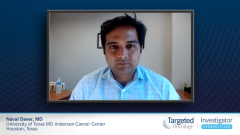
Treating Patients with High-Risk Myelodysplastic Syndrome
An expert details the treatment options for high-risk myelodysplastic syndrome.
Episodes in this series
Naval Daver, MD: Each year, of all the patients with
The second goal is the same as in lower risk, which is to reset the normal hematopoietic equilibrium in the bone marrow, to start producing healthy and higher amounts of red [blood] cells, platelets, and white cells to mitigate the cytopenias that are seen; these are usually even more severe in the higher-risk MDS.
How do we achieve these? We have different treatments in the high-risk MDS. The most used drugs in the United States and probably in the world for the higher-risk MDS populations are a group of drugs called hypomethylating agents [HMAs], or demethylating agents. These are not traditional cytotoxic chemotherapy; they’re not designed to kill cells like we use chemotherapy for in many solid tumors, but are actually epigenetic-modifying drugs. These have been approved about 15 to 18 years ago. Many of the studies that led to their approval were led by investigators at the [University of Texas] MD Anderson Cancer Center at that time; these studies showed a response rate of about 30% to 40% complete remission or marrow remission with hematological recovery in patients with high blasts, higher-risk MDS. These are also associated with an improved survival compared to the traditional therapies such as hydroxyurea, observation, or growth factors that were available at that time. These are probably the bread and butter of treatment. However, 35%, 40% is not ideal; a lot of efforts are ongoing to improve that response rate by adding other drugs—immune drugs, targeted drugs, apoptosis-stimulating drugs—to that backbone of HMA therapy.
Now there are a couple of caveats. We do sometimes consider traditional induction cytotoxic intensive therapy for patients with MDS; who are those patients? Those are usually patients who are younger, below 65 years of age, and present with high blasts, above 10%, 15%. They’re very close to AML, and often the biology and the mutations are very similar to AML. In those patients, when we’re going for curative intent with a hope to get to a stem cell transplant quickly, we may do intensive induction chemotherapy approaches, rapidly followed by allogeneic stem cell transplant after 1 or 2 cycles. In addition, there are certain mutational groups we have started to identify of MDS that behave like AML. This includes patients with NPM1 mutations, those with FLT3 mutations, those with CBL mutations, and then those with inversion 16, 8;21 translocations, core binding factor, or with APL translocation 15;17. These 5 or 6 groups of patients, even though they may have 15%, 10%, even 5% blasts that look like MDS, have biology and response to therapy similar to AML. We treat them with AML-like therapies irrespective of the blasts, and these are called AML defining mutations or cytogenetic abnormalities.
After doing the treatment, whether it’s with hypomethylating epigenetic therapy, a single agent or combination, or with intensive chemotherapy, the goal is to get these people to allogeneic stem cell transplant. If we achieve remission but we cannot go to transplant with the therapies in higher-risk MDS, the duration of response is usually between 6 and 18 months. It is not long term and not curative. Usually, the goal is to transition these people in remission, in a very controlled condition, with count recovery and often in a better physical state to allogeneic stem cell transplant, which then often is curative.
There are some patients who are not eligible for allogeneic stem cell transplant, in which case then we would continue the hypomethylating agent epigenetic therapy. I do have patients who have been on epigenetic therapy for 5 to 10 years and are ongoing if they are not transplant candidates, do not have a good donor, or are too old for allogeneic stem cell transplant. This is kind of the general landscape of treatment for the higher-risk MDS population.
Transcript edited for clarity.









































